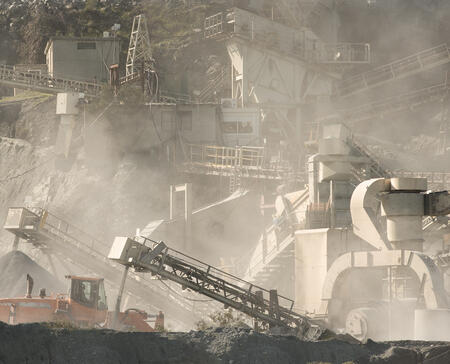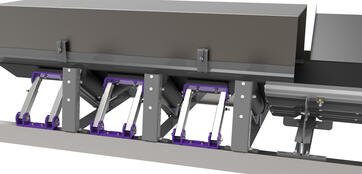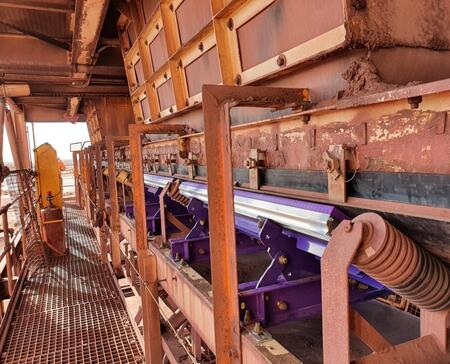In recent years, there has been a successful push by the heavy-duty mining industry to bolster their belt conveying process. While many areas of the belt conveying process have been optimized, one critical issue often remains neglected: belt sag. Addressing this often-overlooked problem could be the key to decreasing downtime and increasing profitability for your operation.
Through the constant conveyance of heavy-duty material, the conveyor belt can lose stretch which causes it to lose proper tension; this is especially true in systems with manual belt take-ups. These belts can also be under tensioned due to damaged take-ups, inoperable take-ups, or very difficult to maintain take-ups, all leading to belt sag.
Although over-tensioning a belt beyond standard parameters can somewhat reduce belt sag, it can also be detrimental to the long-term performance of the conveyor system, the belt, and fasteners. It can even cause increased power draw. In turn, problems arise, impacting overall output and profitability.
But why exactly is belt sag a problem, and what are the negative ramifications that are impacting plant managers that fail to address it?
Consequences of Belt Sag
A sagging conveyor belt should be a major cause for concern for mine operators. When left unaddressed, problems only exacerbate, wreaking havoc on belt conveyor systems and those who work with them. Here’s what you can expect when dealing with belt sag.
Dust & Material Spillage
 Silica dust creation can cause respiratory health issues for workers and fines from MSHA.
Silica dust creation can cause respiratory health issues for workers and fines from MSHA.When a belt is sagging a proper seal cannot be created. This leaves just enough space for rogue material and dust to spill out of your belt conveyor system. This can be a problem for many reasons.
First, obviously, is that this lost material needs to be cleaned up. Plant managers are already stretched thin as it is with trying to delegate tasks to their maintenance teams, and when a sagging belt gets involved, their problems only get worse. Team members will need to be shifted from other important jobs to help clean the material, either putting it back into circulation or risking having to scrap the material altogether. This lost time adds up quickly, detracting from other critical maintenance activities, creating a snowballing effect of delays and inefficiencies that impact your site’s bottom line.
An additional concern lies within the dust that is created and expelled from an exposed load zone caused by belt sag. Not only is inhaling these dust particles highly detrimental to a worker's health and can lead to long-term respiratory issues, but it can also lead to heavy fines from industry governing bodies like the Mine Safety and Health Administration (MSHA) .
Conveyor Belt Damage
The most expensive component of a heavy-duty mine’s belt conveyor system is often the belt itself. When a proper support system is not in place, belt sag can happen, leaving it highly vulnerable to becoming damaged and breaking down.
When rips and tears occur, a maintenance team must take action, either by installing a completely new splice, or by utilizing a conveyor belt rip repair system. In both cases, a real time commitment must be made to address the damage. Allocated time is often a mine’s most valuable asset, so adding something like an unforeseen belt repair to the list of daily tasks only stretches workers thinner than they already are. This is especially true in instances where larger pieces of sediment become stuck between the belt and the skirt, as this will require more extreme repair measures.
Furthermore, a sagging belt can lead to mistracking and other negative consequences that are incredibly difficult to correct. For example, an existing cleaner can become ineffective; if the cleaner choice was designed for a 24” material path and the skirting fails, the material can spread out beyond 24”, bypassing the cleaner.
By actively searching for and implementing solutions that limit belt sag, plant managers can more effectively utilize their workforce, saving precious time for other crucial tasks.
Conveyor System Damage
There are two key areas that are highly susceptible to damage when dealing with belt sag: conveyor idlers and pulley systems. Conveyor idlers, which provide rolling support for the belt, and pulley systems, responsible for driving and guiding the belt, are both highly vulnerable to damage from belt sag.
A sagging belt does not convey smoothly, instead mistracking, moving erratically from the center, and rubbing into preinstalled idlers. This constant abrasion can eat into the structure of the idlers, impacting the overall structural integrity and becoming a potential safety hazard for workers operating on the system. Furthermore, the material that escapes from belt sag can fall to the idlers in the conveyor structure; without a belt plow, this can cause the idlers to seize, allowing material to run back through the tail pulley, damaging both the pulley and the belt.
Like idlers, pulleys share the same unfortunate effects of belt sag and mistracking, but they also are at risk of experiencing excess belt slippage. When a belt is sagging, there is an improper amount of friction on the pulley. If left untreated, the belt can start to slip on the head pulley, moving faster and faster until it turns into a full-fledged fire.
If the material being conveyed is naturally flammable, whether it's something like coal or wood/pulp and paper, this can be catastrophic.
Best Way to Address Conveyor Belt Sag
 Flexco’s Belt Support Bar (BSB) provides immediate support for heavy-duty conveyor belts that keeps material and dust contained.
Flexco’s Belt Support Bar (BSB) provides immediate support for heavy-duty conveyor belts that keeps material and dust contained.Having worked extensively with key field staff at Flexco, one thing that we have frequently noted is that idlers aren’t installed properly. Commonly, rollers are installed too far apart, leading to belt sag that initiates all the aforementioned problems.
There are a few ways that maintenance teams try to address belt sag. One way is by utilizing impact/slider beds. Although this can seem like a good idea, an impact bed often offers a more localized solution at the load zone and can fail to address the actual areas that need assistance. Another way is by attempting to tighten idlers. This method is generally unsuccessful, as just jamming more idlers closer together doesn’t create a truly flat sealing surface.
Instead, the most effective way to create a strong seal in those sagging spots that are downstream of the load zone is to utilize a Belt Support Bar .
Providing your belt with some level of support is crucial for avoiding belt sag and the negative effects that come with it. The Flexco Belt Support Bar effectively provides operators with belt support at a much quicker rate than previously thought possible.
By bolting to the side of the conveyor structure between idlers, a maintenance team can easily install Belt Support Bars on their system by pushing them directly into the belt, all without having to move the belt itself. This is incredibly convenient for installation teams as they no longer need to lift the belt or completely remove it, saving them time and the hassle of a physically demanding job.
After implementation, sites can unlock a more efficient material containment process, as their installed belt skirting systems create a more effective seal. In turn, less material is dispersed, meaning workers are at less risk of long-term health issues, and fewer resources have to be wasted to properly clean piles of spillage.
Proactive Conveyor Maintenance Unlocks Long-Term Rewards
 Combining a Belt Support Bar with a Skirting System creates a high-level of seal that keeps material within the belt conveying process.
Combining a Belt Support Bar with a Skirting System creates a high-level of seal that keeps material within the belt conveying process.While conveyor belt sag might not be a top priority for your facility, the reality is that leaving it unaddressed can lead to a host of costly problems like material waste and extensive conveyor system and belt wear. For heavy-duty mining plants, these issues not only disrupt productivity but also chip away at profit margins.
Although your maintenance team already has a full plate, proactively addressing belt sag through a belt support system can reduce future maintenance needs, extend the life of your system, and minimize costly downtime. In the long run, investing in the right tools translates into a more efficient conveyor process and a healthier bottom line.
Support both your conveyor belt and your maintenance crew by investing in a belt support system today!
Authored by: Kevin Fales, Product Manager
In the role of Product Manager, Fales manages the Belt Conveyor Product line, providing strategic guidance for the global business unit. This includes identifying product development opportunities and working with global engineering resources to create new product concepts and enhance existing products that meet local market requirements. Fales has been with Flexco since 2010, beginning his time as a Marketing Specialist before moving into the Product Manager position. He graduated from Grand Valley State University with a bachelor’s degree in Marketing, and from Western Michigan University with a Master of Business Administration.